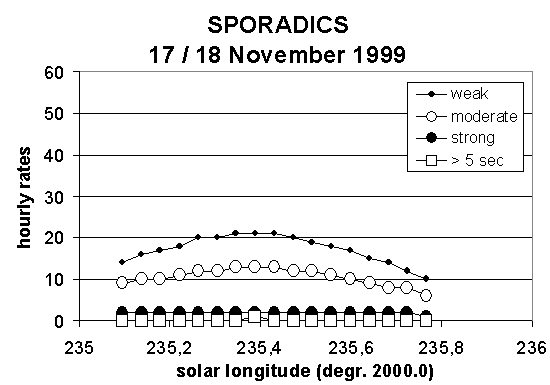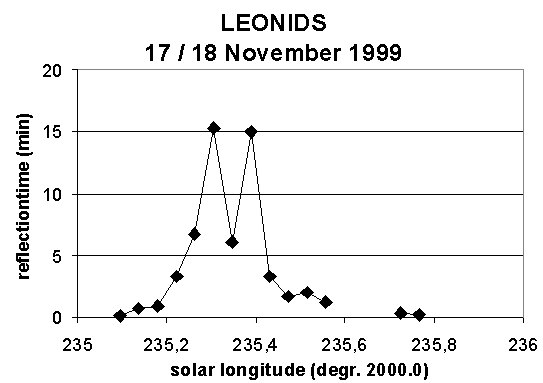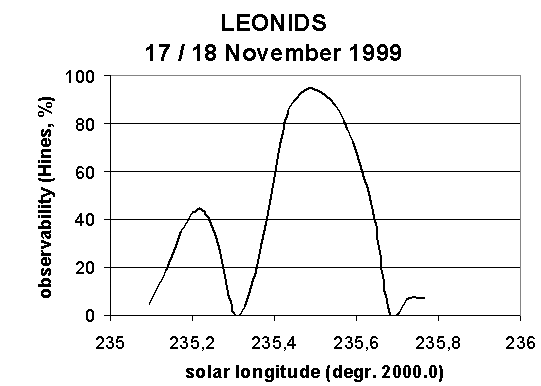|
1. Erwin van Ballegoij : Visual observations 2. Ton Schoenmaker : Visual observations 3. Ton Schoenmaker : Forward Scatter Meteor observations 4. Hendrik Vandenbruaene : Visual observations 5. Wim Zanstra : Forward Scatter Meteor observations |
Hello everybody,
I was planning to start November 12/13 with my Leonid campaign. The
weekend stayed cloudy, but monday started promissing. But towards the
evening it started to get cloudy again (hurricane Lenny was
approaching). A small hole in the cloudcover allowed we to watch about 5
minutes of the tranist of Mercury. Next day hurricane Lenny passed north
from Aruba. The clouds, wind, thunder and rain accompanying this
hurricane kept me from observing the next night.
In the morning of November 17 there appeared small holes in the clouds,
which became bigger during the day. After a nap in the evening I went to
my preferred observing site near the Yamanota (a hill). At 4h30m UT I
started observing. The conditions were bad. There was a very thin
cirrus, which was illuminated by the moon. But stars of the fourth
magnitude were still visible through the cirrus. Where there was no
cirrus the sky had a limiting magnitude of 5.3. The amount of cirrus
increased during the first 45 minutes of my observing session, and when
the limiting went down to the third magnitude I took a break. During the
first 45 minutes I saw only 1 Leonid. I think this number is low, even
considering the bad conditions and the fact the radiant was at first
below and later a bit above the horizon. But a nice -1 white-yellow
Northern Taurid compensated for the low Leonid activity.
A short time later the cirrus started to disappear, and the limiting
magnitude went up to 5.4. The moon was still disturbing too much. The
radiant was rising, and during the second hour I observed 4 Leonids.
Still low.
The third hour I saw 10 Leonids, one of magnitude 0, the brightest one I
saw this night. The moon did set shortly after 6h UT, causing an
improvement of the limiting magnitude to 5.9.
At 7h30m UT I had to stop observing. I had to get some sleep before I
had to go to work. Coming night I will try another observing session.
Obs: Erwin van Ballegoij VANER
Loc.: Yamanota, Aruba, the Dutch Caribbean, 12d29'N, 69d57'W
Date: November 17/18, 1999
UT Teff Lm F LEO NTA STA AMO SPO Total
4:30-5:15 0.62 4.55 1.16 1 1 1 0 2 5
5:37-6:30 0.75 5.28 1.01 4 0 0 0 5 9
6:30-7:30 0.75 5.91 1.02 10 1 1 0 7 19
-- - - - - --
15 2 2 0 14 33
(Classification of minor stream members by plotting all non-Leonids)
-1 0 +1 +2 +3 +4 +5 Total
LEO 1 1 3 6 2 2 15
NTA 1 0 0 0 1 0 0 2
STA 2 2
SPO 3 7 4 14
(All stream abbreviations are IMO abbreviations)
Yours,
Erwin van Ballegoij
--
**********************************************
* Erwin van Ballegoij en Heidi van der Vloet *
* Tarabanaweg 9 *
* Oranjestad, Aruba *
* tel: ++ 297 821918 *
* e-mail: ballegoy@setarnet.aw *
**********************************************
From 5 to 19 November 1999 I visited the beautiful island of
La Palma, Canary Islands, both for holidays and observing.
My wife and I rented a little casita on the Western part of
the island near the small village San Nicolas. There were
not many disturbing lights in this area, but due to the
influence of the nearby Atlantic Ocean the limiting magnitude
was never much better than about magnitude 6. During the first
week the nights were mostly free of clouds, but after Sunday
14 November the weather changed. Temperature dropped,
the wind started to blow and even occasional showers spoiled
the good reputation of the island. But in the early mornings
the weather still was OK and so I observed my first Leonids on
14 November. Reminding the surprise of last year I was alert
during 16/17 November. In the beginning of the night it was
cloudy, but the skies cleared after 2h UTC. Between 2h55m and
5h11m I observed 6 Leonids with Teff = 1.0 hours and Lm = 5.6.
The next night 17/18 November the weather was worse. At about
midnight I started my radio observations. Heavy rain and wind
and no signs of improvement. Around 2h UTC I received many loud
radio reflections from a TV transmitter in Muro, Portugal.
Apparently there was a very nice show going on, but I was
not on the right spot on Earth and frustated I listened
to the fireworks on the radio. At last, at 3h30m the weather
improved and I could start observations at 3h36m. Even then
the activity was still pretty high: about 2 meteors per minute.
This number slowly went down until I had to stop observations
at 6h33m because of dawn. All in all, a night to remember, but
hopefully next time a bit less interference of the weather.
Below follows an overview of my observations, keep in mind
I am more used to observe radio meteors rather than visual ones!
Ton Schoenmaker
Meester Homanstraat 8
9301 HP Roden, The Netherlands
e-mail: schoenmaker@nfra.nl
observer: Ton Schoenmaker
date: 17/18 November 1999
location: San Nicolas, La Palma, Canary Islands
28.59 North, 17.87 West
observations near zenith
ZHR calculated using r=2.5
---------------------------------------------------
UTC Teff Lm Leo spo elev ZHR
03h36m - 04h01m 0.32 5.5 35 1 39 430
-1 0 +1 +2 +3 +4
Leo 1 11 9 9 4 1
spo 1
---------------------------------------------------
UTC Teff Lm Leo spo elev ZHR
04h07m - 04h39m 0.40 5.5 24 0 48 200
-4 -2 -1 0 +1 +2 +3 +4
Leo 1 1 1 5 7 4 4 1
---------------------------------------------------
UTC Teff Lm Leo spo elev ZHR
04h57m - 05h28m 0.46 5.5 20 2 57 130
-2 -1 0 +1 +2 +3
Leo 1 1 6 2 7 3
spo 2
---------------------------------------------------
UTC Teff Lm Leo spo elev ZHR
06h18m - 06h33m 0.23 5.5 7 2 72 82
0 +1 +2 +3 +4
Leo 2 1 2 2
spo 1 1
---------------------------------------------------
Forward Scatter Meteor Observations of Leonids 1999
Observer: Ton Schoenmaker Location: San Nicolas, La Palma, Canary Islands (17°52'W, 28°35'N) Frequency: 48.242 MHz (TV video signal) Transmitter: Muro, Portugal; distance 1580 km Antenna: dipole, geographical azimuth 45 degrees (NE) Receiver: Yupiteru MVT-9000 Observing: listening and counting 1000 Hz pings/bursts with receiver in USB mode
To observe the predicted shower of the Leonids visually, I decided to travel to La Palma, as weather conditions are usually not good in The Netherlands during the Leonids. To be able to do also some monitoring of forward scatter, I carried with me a Yupiteru scanner and a simple dipole. After some experimenting, I found out that I could hear pings from an E-2 (48.242 MHz) TV transmitter, very probably located in Muro, Portugal. During the week from 8 to 13 November I determined the sporadic level to be about 25 loud pings and bursts per hour at 0h UTC. The number of reflections rose slowly to a maximum of about 45 per hour at 6h UTC, and reached a minimum of about 5 per hour at 18h UTC.
Unfortunately the weather turned out not to be as good as usual. During the nights of 16/17 and 17/18 November there was wind and rain. This gave me time to listen to the radio and monitor the Leonid activity. Only loud pings and bursts were counted. Especially during the maximum on 17/18 November around 2h UTC there were numerous loud bursts beginning with a large Doppler shift and a few seconds duration. The radiant at that time was at azimuth 73 degrees, nearly in the direction of the transmitter, so the meteors came head-on in my direction. This effect and the 71 km/s velocity of the Leonids probably caused the large Doppler shift. This geometry is not favourable for specular reflections of underdense meteors, but as I only counted strong overdense signals, the observability is hardly relevant. The table below gives the number of counts per observation period as well as converted to the Radio Hourly Rate (RHR). By subtracting the average level of sporadics, this total RHR is corrected to the Leonid RHR (figure 1). My Leonid observations of 1998 showed, that the effect of radiant elevation could be corrected pretty well by 1/(sin(elevation)). After applying this correction the final column gives the Leonid Zenith Radio Hourly Rate (ZRHR) and its mean error. Of course the ZRHR is no absolute number, but after normalising it may be compared to the visual ZHR.
I have to confess that I felt rather frustrated knowing that the Leonids were very active, but not to be able to see them because of the clouds. After 3h30m UTC the clouds disappeared and at that time I still observed about 2 meteors per minute.
Overview of forward scatter observations:
16/17 November 1999 loud total spor. Leo radiant Leo
UTC Teff refl. RHR RHR RHR elev. ZRHR
00h52m - 01h12m 20m 12 36 30 6 4 -
02h24m - 02h39m 15m 11 44 38 6 22 16 +/- 5
03h45m - 04h00m 15m 15 60 43 17 40 26 +/- 7
05h16m - 05h31m 15m 15 60 45 15 59 18 +/- 5
09h45m - 10h01m 10m 3 18 20 -2 58 -
11h53m - 12h08m 15m 3 12 10 2 30 -
17/18 November 1999 loud total spor. Leo radiant Leo
UTC Teff refl. RHR RHR RHR elev. ZRHR
00h18m - 00h33m 15m 10 40 28 12 -4 -
01h19m - 01h33m 14m 9 39 33 6 9 -
01h39m - 01h49m 6m 8 80 35 45 13 200 +/- 70
01h50m - 01h57m 7m 19 163 36 127 15 491 +/- 113
02h00m - 02h10m 8m 50 375 37 338 17 1156 +/- 163
02h10m - 02h20m 6m 20 200 37 163 19 501 +/- 112
02h20m - 02h31m 10m 22 132 38 94 21 262 +/- 56
02h46m - 02h56m 9m 20 133 40 93 27 205 +/- 46
04h45m - 04h55m 8m 9 68 44 24 53 30 +/- 10
06h00m - 06h15m 15m 20 80 45 35 70 37 +/- 8
12h39m - 12h54m 15m 6 24 10 14 19 43 +/- 18
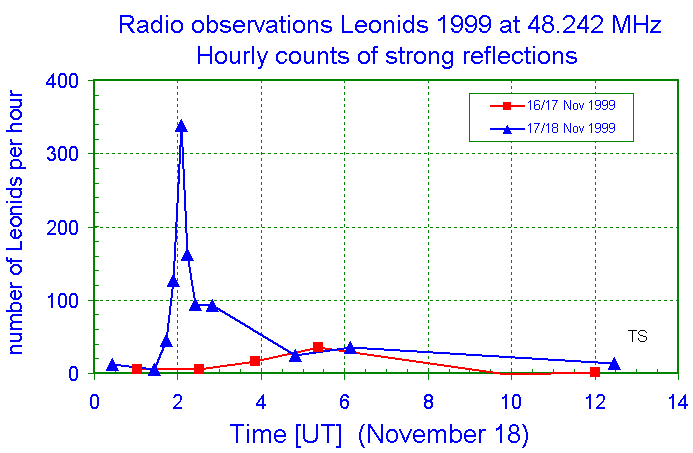
Ton Schoenmaker, Dutch Meteor Society
Meester Homanstraat 8, NL-9301 HP Roden, Netherlands
E-mail: schoenmaker@NFRA.nl
Call: PA0EFA
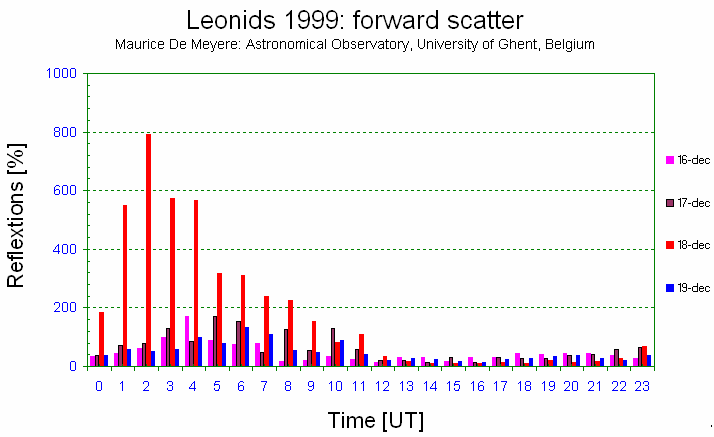
Location: Astronomical Observatory, University of Ghent, Belgium (ED50 coordinates: 3 42' 32" E, 51 01' 25" N) Antenna (2x): 4 elements horizontal Yagi, pointed East, elevation= 20 deg Antenna amplifier: 10 dB gain narrow band resonance lambda/4 antenna filter Frequency: (1)=66.29 MHz (signal) and (2)=65.3 MHz (interference control) Receiver (2x): modified commercial FM receiver Data acquisition: 12 bits PC-based A/D convertor, 250 Hz sampling rate Interference rejection: dual setup: receiver (1) tuned at distant transmitter, receiver (2) tuned at empty frequency. Anti-coincidence measurement rejects registration of broadbanded spurious signals (lightning, computers, ignition motors, etc). Further information: see WWW page (additional info + observational data) http://allserv.rug.ac.be/~hdejongh/astro/meteor/meteor.html Data format: results are shown as total reflection time, expressed as a percentage. The actual number shows 10 times this value. When no figure is shown, the equipment was either out of service, or results could have been affected by interference, sporadic-E.

Observer: Ilkka Yrjola Location: Finland (26 35' E, 60 54' N) Frequency: 88.8 MHz ? Receiver: Salora SRP-22 modified, narrow band FM (B=15 kHz)? detected signal level >-122 dBm. FM detection, no pulse noise rejection required. Antenna: 2-el. Yagi, G=4 dBd to SW, azimuth 45 deg (SW), polarisation H. Data sampling system: threshold triggering, sampling rate 32 ms. Computer logs total hourly elapsed reflection time, number of triggers for the hour, the longest time the signal was continuously above detection level for the hour. Data on major showers available in the Compact MS-Soft format. Software for viewing available from www.saunalahti.fi/~oh5iy/radio50.zip (754 K).
(VVS - Belgium)
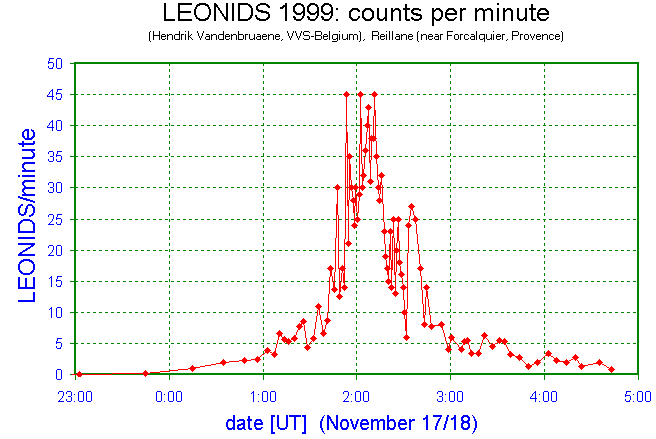
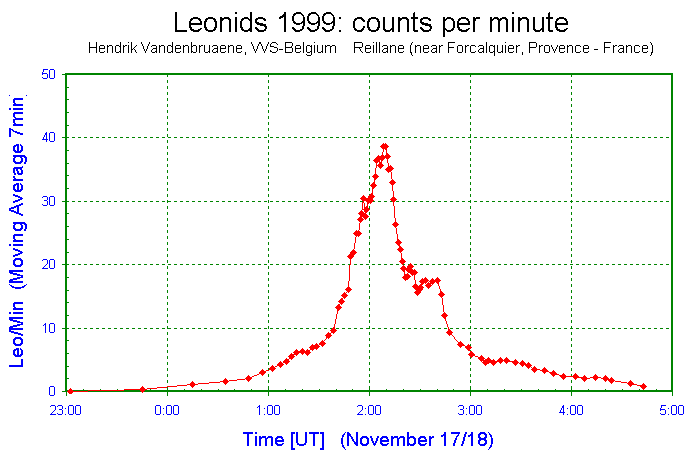
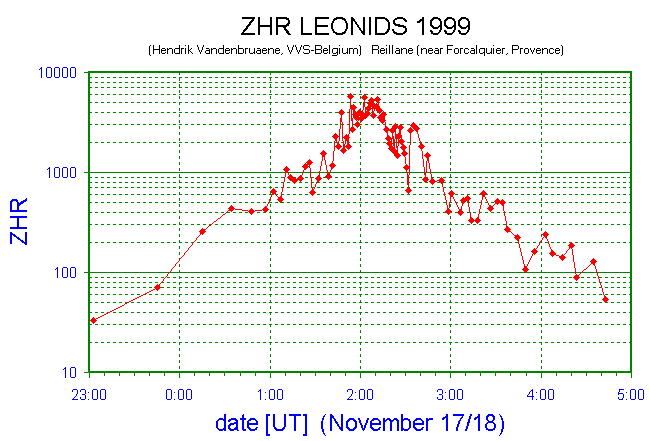
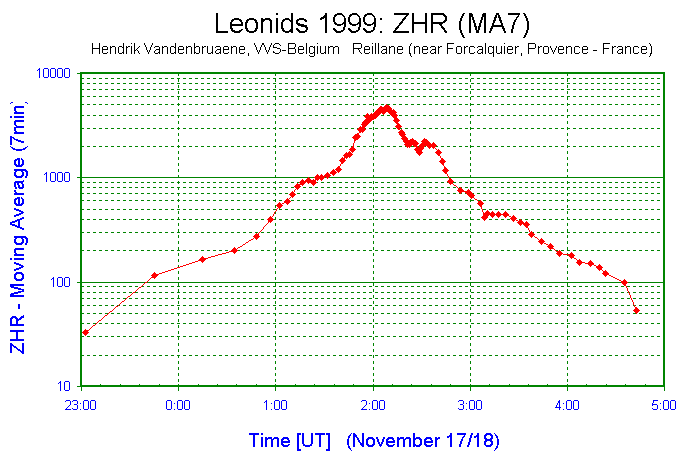
LEONIDS 1999: 16, 17, 18 November
During the nights of 16 / 17 and 17 / 18 November the Leonids were observed from the location Appingedam, The Netherlands by listening to the reflections of radiowaves caused by the meteors. A transmitter in Wroclaw, Poland was used at the frequency of 72,11 MHz. The reflected waves were catched by a 5 elements Yagi antenna directed to the area in the atmosphere half way transmitter and receiver 100 km above the earth surface. This is the so called forward scattering method.
As receiver was used a Bearcat UBC 177 XLT radio scanner with a sensibility of 0.3 microVolt. The signals were registrated by listening with a headphone.
By distinguishing between weak, moderate, strong and long signals it became possible to learn more about the composition of the Leonids, also compared to the sporadic background. The last was derived from series of observations since 1995 and is the yearly mean value. The reflectiontime of the meteors was registrated too. All countings were corrected for breaks and reflectiontime and became hourly rates.
The following 3 figures show the results of the observations made from November 17, 21 UTC till November 18, 14 UTC. Timebase is the solar longitude in degrees (2000.0). The last figure shows the Hines' observability function, giving the possibility of catching a reflection on the receiver antenna.
Wim Zanstra
Spijkerlaan 13
9903 BB Appingedam
The Netherlands
Tel: +31-596-625617
E-mail: wimzanstra@freemail.nl
Observer : W.T. Zanstra
Location : Appingedam, Netherlands (6 degr 51' E, 53 degr 19' N)
Frequency : 72.110 MHz (forward scattering)
Transmitter: Wroclaw, Poland (16 degr 43' E, 50 degr 52' N), distance 735 km, power?
Antenna : 5 elements Yagi, elevation 12 degr, azimut 110 degr (ESE)
Receiver : Bearcat UBC 177 XLT scanner, sensitivity 0.3 microVolt
Observing method: listening by headphone
November 16, 1999
| Leonids incl sporadics | sporadics | Fobs | refl.
UTC | weak moderate strong >5sec | weak moderate strong >5sec | (%) | time
--------------------------------------------------------------------------------
21 - 22 | 13 13 1 1 | 14 9 2 0 | 0 | 11
22 - 23 | 7 6 1 0 | 16 10 2 0 | 18 | 0
23 - 24 | 19 10 1 0 | 17 10 2 0 | 36 | 2
November 17, 1999
| Leonids incl sporadics | sporadics | Fobs | refl.
UTC | weak moderate strong >5sec | weak moderate strong >5sec | (%) | time
--------------------------------------------------------------------------------
08 - 09 | 10 13 4 3 | 18 11 2 0 | 85 | 24
09 - 10 | 18 18 2 4 | 17 10 2 0 | 68 | 29
10 - 11 | 14 6 1 1 | 15 9 2 0 | 42 | 14
11 - 12 | 11 8 1 0 | 14 8 2 0 | 13 | 5
12 - 13 | 11 16 1 0 | 12 8 2 0 | 5 | 5
13 - 14 | 7 10 1 0 | 10 6 1 0 | 5 | 0
--------------------------------------------------------------------------------
21 - 22 | 12 17 0 0 | 14 9 2 0 | 5 | 7
22 - 23 | 11 8 1 1 | 16 10 2 0 | 19 | 40
23 - 24 | 16 10 2 2 | 17 10 2 0 | 37 | 55
November 18, 1999
| Leonids incl sporadics | sporadics | Fobs | refl.
UTC | weak moderate strong >5sec | weak moderate strong >5sec | (%) | time
--------------------------------------------------------------------------------
00 - 01 | 8 20 3 5 | 18 11 2 0 | 44 | 195
01 - 02 | 22 48 8 18 | 20 12 2 0 | 29 | 399
02 - 03 | 27 57 8 29 | 20 12 2 0 | 0 | 915
03 - 04 | 1 33 5 11 | 21 13 2 1 | 14 | 366
04 - 05 | 14 40 5 23 | 21 13 2 1 | 48 | 897
05 - 06 | 15 21 6 9 | 21 13 2 0 | 84 | 196
06 - 07 | 22 30 2 3 | 20 12 2 0 | 94 | 99
07 - 08 | 20 11 3 4 | 19 12 2 0 | 93 | 118
08 - 09 | 18 20 4 3 | 18 11 2 0 | 85 | 74
--------------------------------------------------------------------------------
12 - 13 | 29 21 4 0 | 12 8 2 0 | 7 | 15
13 - 14 | 14 13 2 1 | 10 6 1 0 | 7 | 11
The numbers are hourly rates, corrected for reflectiontime and breaks. The reflection time is counted in seconds and corrected in the same way. The sporadics were observed during several years since 1995. The levels are adapted to recent countings of sporadic meteors. Fobs is the Hines' observability function. Leonid activity was dominated by the moderate and long reflections. More countings were done on November 17 from 00 - 08 UTC and recorded on a video tape that still has to be worked out.
Wim Zanstra
Spijkerlaan 13
NL-9903 BB Appingedam
The Netherlands
Tel: +31-596-625617
E-mail: wimzanstra@freemail.nl

